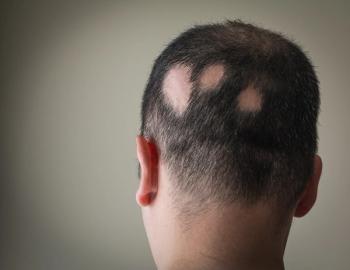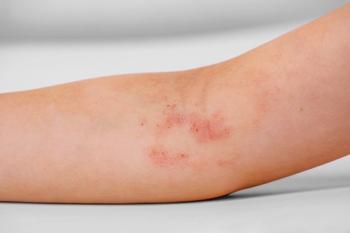
- Consultant for Pediatricians Vol 9 No 4
- Volume 9
- Issue 4
Can you identify the intensely itchy plaques on this girl’s leg?
This 11-year-old girl has had an intensely itchy rash on her left leg for the past 10 years. It has been slowly progressing, to the point that it now extends the entire length of the leg. She has become extremely frustrated by the recurring bouts of itchiness and is desperate for relief.
Case:
This 11-year-old girl has had an intensely itchy rash on her left leg for the past 10 years. It has been slowly progressing, to the point that it now extends the entire length of the leg. She has become extremely frustrated by the recurring bouts of itchiness and is desperate for relief.
What are these lesions-and how likely is it that treatment will provide the relief the patient is hoping for?
Answers on Next Page
Case: Inflammatory linear verrucous epidermal nevus, which is very resistant to treatment
Inflammatory linear verrucous epidermal nevus (ILVEN) is a neurocutaneous hamartoma of ectodermal origin. Epidermal nevi have a reported incidence of between 1 and 3 in every 1000 live births; they occur equally often in males and females. ILVEN accounts for about 6% of epidermal nevi; in contrast to other epidermal nevi, however, ILVEN has been reported to have a 4:1 female to male predominance. Although the majority of cases are sporadic, a familial association of ILVEN has been documented.
Characteristic features of ILVEN. ILVEN presents with linear, erythematous, verrucous plaques in a distribution along the lines of Blaschko. The condition may be present at birth but typically develops during early infancy as erythematous warty lesions that coalesce to form plaques. ILVEN is typically unilateral and located on the left side; it usually involves the buttock and/or lower limb. Thus, this patient's presentation is quite typical. However, ILVEN has been reported on the right side and on the groin, trunk, adnexa, and upper limb (including the hand). The principal features that help distinguish ILVEN from other epidermal nevi are the inflammatory (erythematous) nature of the lesions and the presence of pruritus. ILVEN's notorious resistance to treatment may help distinguish it from psoriasis. The history taking and physical examination may reveal associated cutaneous and extra-cutaneous abnormalities-most commonly skeletal deformity on the ipsilateral side and neurological complaints, including seizure, mental retardation, and structural changes in the CNS.
Diagnosis. The differential diagnosis for ILVEN includes other forms of epidermal nevi, linear psoriasis, lichen nitidus, lichen striatus, linear lichen simplex chronicus, and possibly a linear distribution of human papillomavirus–induced warts. Distinguishing ILVEN clinically from other forms of epidermal nevi and psoriasis may be possible; however, biopsy may need to be performed to rule out other linear eruptions, especially linear epidermal nevi and lichen striatus. In this patient, biopsy was performed on the basis of clinical suspicion.
Therapy. Treatment of ILVEN is difficult and must be individualized. It is essential when treating ILVEN that patient expectations be adequately managed. The first therapeutic interventions to be tried are typically topical and intralesional corticosteroids, which may temporarily reduce the inflammatory component and the itch. Topical vitamin D3 and calcipotriol can be successful in relieving pruritus and hyperkeratosis. However, the effects of these agents are rarely permanent; in addition, caution must be exercised with respect to the weekly quantities used, to avoid disturbances of calcium metabolism. Topical retinoids and 5-fluorouracil have been effective in reducing the epidermal thickening and the visibility of epidermal nevi; however, their use intensifies the itch of ILVEN, and an adequate therapeutic trial is often difficult. Surgical excision and destructive therapies, such as dermabrasion, cryotherapy, and laser therapy, may offer definitive therapy for smaller lesions that can be completely destroyed.
A principal goal of management should be to control the extreme pruritus of ILVEN, which is often a primary source of morbidity. ILVEN tends to spontaneously remit in adulthood, but until that time, patients experience recurring episodes of intense itch. Some patients may require referral to a specialist. Decisions to refer are guided by the clinical presentation, in particular the presence of extra-cutaneous pathology.
Outcome of this case. This young girl has responded to treatment with topical corticosteroids and calcipotriol. She has less itching and fewer scales on her lesions; however, the lesions do persist.
Articles in this issue
over 15 years ago
10 Tips for Staying Safe on Social Networking Sitesaover 15 years ago
Acute Parotiditis After MMR Vaccinationover 15 years ago
Developmental Delay in a Teen With Neurofibromatosis Type Iover 15 years ago
Omental Cyst Presenting as Acute Abdomenover 15 years ago
Fatal Case of Juvenile Hemochromatosisover 15 years ago
Promoting Safe Use of Electronic Mediaover 15 years ago
Fever and Neck Swelling in a Toddler With Growth DelayNewsletter
Access practical, evidence-based guidance to support better care for our youngest patients. Join our email list for the latest clinical updates.














